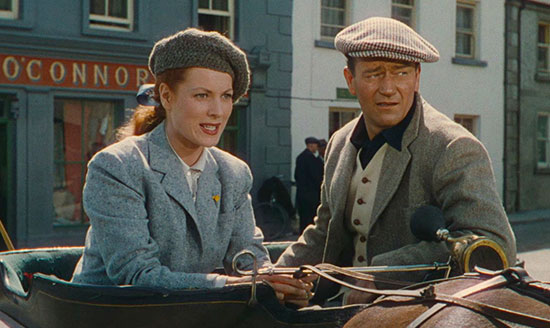Classic Hollywood: Films of ’52: The Quiet Man

“I’m John Ford, and I make Westerns,” said the Maine-born filmmaker in one of the great understatements of all time. Ford didn’t just make Westerns – he was synonymous with them. But did you know that none of his seven Academy Awards were for his trademark genre? To me, that would be like Alfred Hitchcock copping Oscars for directing musicals, or any movies for that matter. (The Master of Suspense went zero-for-five during his career.)
In addition to scoring awards for wartime documentaries and producing, Ford won Best Director honors for The Informer (1935), The Grapes of Wrath (1940), How Green Was My Valley (1941), and The Quiet Man (1952), which many consider Ford’s valentine to Ireland, his ancestral home. Truly a passion project, The Quiet Man took 16 years to go from pipe dream to box-office hit. Unlike Ford’s other pics, this one wasn’t released by a major studio; instead, “Poverty Row” pipsqueak, Republic Pictures, best known for “B”-Westerns, financed “Pappy” Ford’s tale.
As usual, Ford tapped John Wayne for the lead role, which was also a departure for the actor. Typecast in cowboy flicks and “rah-rah” war films, Wayne flexes his rom-com chops as American boxer Sean Thornton, who returns to his native Emerald Isle after accidentally killing an opponent in the ring. His arrival causes a kerfuffle among the village locals, particularly flame-haired Mary Kate Danaher (Maureen O’Hara), whose big bro tries to keep the fighter and his sister apart.
TCM.com’s Rob Nixon nails The Quiet Man’s enduring charm: “This is the Ireland of [Ford’s] imagination and longing, the same sentiment felt by [Wayne’s character] when he arrives from America seeking the ‘heaven’ his dead mother told him about. Ford’s Ireland is peopled by impish, good-hearted folk (even Mary Kate’s oafish brother has his clumsy soft spots), living in fairy tale thatched cottages surrounded by the lush green countryside (a natural environment given a tremendous boost by Winton Hoch’s Oscar®-winning color photography).”
Leprechaun-ish Oscar winner Barry Fitzgerald (Going My Way) tops the supporting cast, which includes his real-life brother Arthur Shields (as the vicar who conspires to bring Sean and Mary Kate together); Ford stock company vets Ward Bond and Victor McLaglen; O’Hara sibling Charles Fitzsimons, Ford’s older brother Francis, and four of Wayne’s children (who appear in the steeplechase scene).
The chemistry between Wayne and O’Hara is palpable and effortless. The two were pals off screen, and generated heat on it: The last scene in The Quiet Man, when O’Hara whispers into Wayne’s ear, and his face registers shock, was genuine. Apparently, Ford told her to say something very naughty to Wayne, whose reaction was priceless. Wayne’s son Michael summed up the pair’s appeal: “She could match John Wayne kiss for kiss, punch for punch, stride for stride.”
I also love this anecdote from O’Hara’s New York Times obituary – it captures the closeness the five-time co-stars shared: “Wayne once paid her what he considered the highest compliment. ‘I’ve had many friends, and I prefer the company of men, except for Maureen O’Hara,’ he said. ‘She is a great guy.’”
Watching them in The Quiet Man, it’s clear their mutual admiration required no acting whatsoever.
Classic Hollywood posts appear bimonthly on The Music Hall blog.
